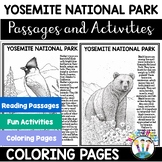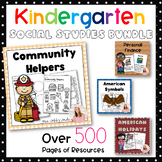18 results
Civics Common Core L.11-12.5 resources

The Constitutional Convention – New Jersey / Virginia Plan Comparison Grid
When delegates from the twelve attending states gathered in Philadelphia during the Summer of 1787 (Rhode Island sent no representatives), the convention's outcome was far from certain. Its official purpose was to reform the Articles of Confederation. However, for many of the men who came, mere reforms would not be enough.This side-by-side comparison grid explores the chief ideological conflict of the US Constitutional Convention: Big States vs. Small States. By exploring the New Jersey and Virg
Subjects:
Grades:
6th - 12th, Higher Education, Adult Education
Types:
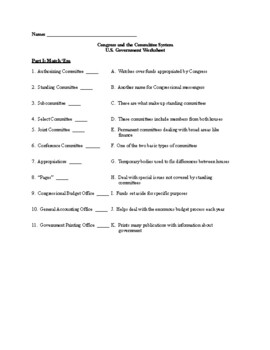
Congress: The Committee System
In order to more efficiently conduct the business of the United States, Congress divides its workload up among a variety of committees and subcommittees. As a result of this however, both the Senate and House of Representatives are home to a bewildering array of legislative sub-bodies, each with its own purpose and agenda.This 'match-em' and short answer worksheet is designed to help students navigate the complicated world of congressional committees. Using 'match-ems' and short answer questions
Subjects:
Grades:
9th - 12th, Higher Education
Types:

AP® US Government Unit 1.9 - Federalism in Action (American Federalism)
Unit 1.9 of the AP® Curriculum devotes itself to the daily practice of American federalism, and seeks to answer the following two questions: (1) based on the constitution, where does federal power end and state power begin? And (2) how does this balance impact the policymaking process?This short answer worksheet deals extensively with constitutional power, beginning with definitions of the various types of power (expressed, implied, etc.) that coexist within American government. The questions th
Subjects:
Grades:
11th - 12th, Higher Education
Types:
Also included in: AP® US Government - Comprehensive Full-Year Accompanying Curriculum

AP® US Government Unit 1.7 - Federalism in Focus Reading Quiz
Unit 1.7 of the AP® curriculum is devoted to questions surrounding the allocation of power in the US government, specifically: what is federalism, and why should we care? Where does federal power end and state power begin? And, perhaps most importantly, what role does money play in this whole process?This reading quiz is based upon "Federalism in Focus," a 2500-word essay that that is designed to help students prepare for the AP US Government Exam. The text and quiz both cover each of the foll
Subjects:
Grades:
11th - 12th, Higher Education
Types:
Also included in: AP® US Government - Comprehensive Full-Year Accompanying Curriculum

Comparing & Contrasting Systems of Government
For those of us fortunate to live under a democratic, representative system of government, it can be easy to take our country's political institutions for granted. Yet many people on Earth live under repressive, even violent, regimes, where any form of protest can lead to a lengthy prison sentence.This 'cheat sheet' comparison grid analyzes the various form of government that exist around the world - from republics to theocracies to oligarchies - and provides students with a meaningful snapshot
Subjects:
Grades:
10th - 12th, Higher Education
Types:

AP®US Government Unit 1.5 - Ratification of the Constitution (Short Answer, T/F)
Unit 1.5 of the AP® curriculum emphasizes compromise & negotiation - both the compromises necessary to ratify the United States's constitution, as well as the ongoing role that negotiation and dialogue continue to play in its government.This worksheet consists of two sections, each designed to challenge and improve your students' understanding of the Constitutional Convention: Section 1 contains two short answer/identification questions about the role(s) played by the convention's main perso
Subjects:
Grades:
11th - 12th, Higher Education
Types:
Also included in: AP® US Government - Comprehensive Full-Year Accompanying Curriculum

AP® US Government Unit 1.9 - Federalism in Action (Relations Among the States)
Unit 1.9 of the AP® Curriculum devotes itself to the daily practice of American federalism, including questions about how power is shared among the states: what is the process of adding a new, equal state? What responsibilities and obligations do states have once they are admitted to the Union?This two-part worksheet traces the evolving process of statehood, and uses the constitution's own words to help further students' understanding of state-to-state and state-to-federal relations.Part I is a
Subjects:
Grades:
11th - 12th, Higher Education
Types:
Also included in: AP® US Government - Comprehensive Full-Year Accompanying Curriculum

AP® US Govt 1.7 Text - Federalism in Focus (Relations b/w State & Federal Govts)
Unit 1.7 of the AP® curriculum is devoted to questions surrounding the allocation of power in the US government, specifically: what is federalism, and why should we care? Where does federal power end and state power begin? And, perhaps most importantly, what role does money play in this whole process?"Federalism in Focus" is a 2500-word essay that is designed to help students understand federalism as they prepare for the AP® US Government Exam. Featuring photos, archival newsreel stills, and a s
Subjects:
Grades:
11th - 12th, Higher Education
Types:
Also included in: AP® US Government - Comprehensive Full-Year Accompanying Curriculum
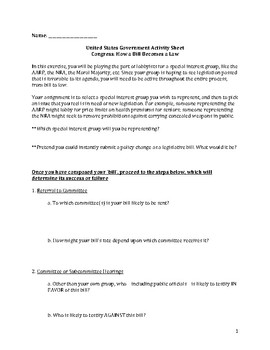
How a Bill Becomes a Law – Classroom Activity & Vocab List
Congress remains one of the least trusted institutions in the United States - some surveys even rank its members behind used car salesmen in terms of reliability.This activity packet helps students understand the legislative process, as they take on the role of imaginary policy activists and craft a 'bill' they would like to see passed. From there they follow their bill through referral and markup to floor debate and beyond. Included with the step-by-step introduction, is a vocabulary list with
Subjects:
Grades:
10th - 12th, Higher Education
Types:

AP® US Government Unit 2.12 - The Federal Bureaucracy
Unit 2.12 of the AP® curriculum focuses on the federal bureaucracy, the so-called "Fourth Branch" of government.This nine-question ID/definition worksheet explores the vocabulary of Commissions, Agencies, Civil Servants, Government Corporations, "Iron Triangles" and more to help students better understand the role that unelected policymakers play in the day-to-day operation of US government. Special attention is also paid to reforms imposed on the Bureaucracy by the 1883 Pendleton Civil Service
Subjects:
Grades:
11th - 12th, Higher Education
Types:
Also included in: AP® US Government - Comprehensive Full-Year Accompanying Curriculum

Congress: How the Legislative Branch Works
Congress remains one of the least trusted institutions in the United States - some surveys even rank its members behind used car salesmen in terms of reliability.This short answer / identification worksheet helps students understand why. Drawing its questions from various terms, issues and controversies involving the legislative branch. Why are there no Congressional term limits? Why are members of Congress regularly reelected if they are so unpopular? What does the Speaker of the House do?Perfe
Grades:
9th - 12th, Higher Education
Types:

AP® US Govt Unit 1.7 - Relationship Between the States and Federal Government
Unit 1.7 of the AP® curriculum is devoted to questions surrounding the allocation of power in the US government, specifically: what is federalism, and why should we care? Where does federal power end and state power begin? And, perhaps most importantly, what role does money play in this whole process?This worksheet combines Fill in the Blank, Multiple Choice, True-False and Short Answer questions to demonstrate how society's needs impact the ever-changing balance of power between the federal an
Grades:
11th - 12th, Higher Education
Types:
Also included in: AP® US Government - Comprehensive Full-Year Accompanying Curriculum

AP US Government: Federalism in Focus – Mini Curriculum to Accompany Unit 1
What is federalism, and why should we care? Where does federal power end and state power begin? And, perhaps most importantly, what role does money play in this whole process?!"Federalism in Focus" is a forty--page mini-curriculum, written with these questions in mind. Whether you are teaching Civics, U.S. Government or preparing a Home School curriculum, this concise-yet-thorough lesson plan can help bring the subject alive for your students!Featuring photos, archival newsreel stills, and a ste
Subjects:
Grades:
7th - 12th, Higher Education, Adult Education, Staff
Types:

Congress and the Public Good
Congress remains one of the least trusted institutions in the United States - some surveys even rank them behind used car salesmen in terms of reliability.This two-part American Government worksheet discusses some of Congress's least popular habits: Pork Barrel Spending, legislative gridlock and, of course, lobbyists. Short answer ID questions will test students' understand of congressional activity and the efforts of lobbyists, and the Internet research activity will help them discover Washingt
Subjects:
Grades:
10th - 12th, Higher Education
Types:

Race & Racism in America - How did We Get Here? (Fill-in-The-Blanks Worksheet)
"How did We Get Here" is a mini-curriculum devoted to investigating the roots of institutionalized racism in the modern United States. This 10-item Fill-in-The-Blanks exercise is based upon the series' 1800-word first installment, which begins with the Civil War's end in 1865. What were the "Civil War Amendments" and "Radical Reconstruction?" When did the last Union Army troops withdraw from the South? Why was Andrew Johnson impeached? What was the Jim Crow Era? This activity seeks to pro
Subjects:
Grades:
6th - 12th, Higher Education, Adult Education
Types:
CCSS:
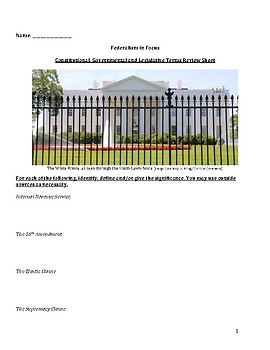
Federalism in Focus - Constitutional, Governmental + Legislative Terms Exercise
What is federalism, and why should we care? Where does federal power end and state power begin? And, perhaps most importantly, what role does money play in this whole process?!"Federalism in Focus" is a 2500-word essay written with these questions in mind. Whether you are teaching Civics, U.S. Government or preparing a Home School curriculum, this concise-yet-thorough reader can help bring the subject alive for your students!This vocabulary worksheet consists of 23 terms, all taken from the text
Subjects:
Grades:
7th - 12th, Higher Education, Adult Education, Staff
Types:
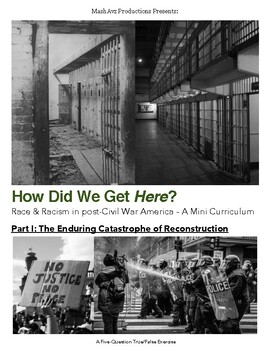
Race & Racism in America - How did We Get Here? (True/False Worksheet)
"How did We Get Here" is a mini-curriculum devoted to investigating the roots of institutionalized racism in the modern United States. This five-item True/False exercise is based upon the series' 1800-word first installment, which begins with the Civil War's end in 1865. What were the "Civil War Amendments" and "Radical Reconstruction?" When did the last Union Army troops withdraw from the South? Why was Andrew Johnson impeached? What was the Compromise of 1877? This free activity seeks
Subjects:
Grades:
6th - 12th, Higher Education, Adult Education, Staff
Types:
CCSS:
AP® US Government Units 1.6-1.9 Vocabulary Exercise (The Language of Federalism)
What is federalism, and why should we care? Where does federal power end and state power begin? And, perhaps most importantly, what role does money play in this whole process?!This vocabulary worksheet consists of 23 terms, It is hoped that by completing this exercise, students will improve their vocabulary, learning comprehension skills, and their understanding of federalism, state-federal balance of power, and the US Constitution. Featuring vocabulary words that range in subject from History t
Subjects:
Grades:
11th - 12th, Higher Education
Types:
Showing 1-18 of 18 results

